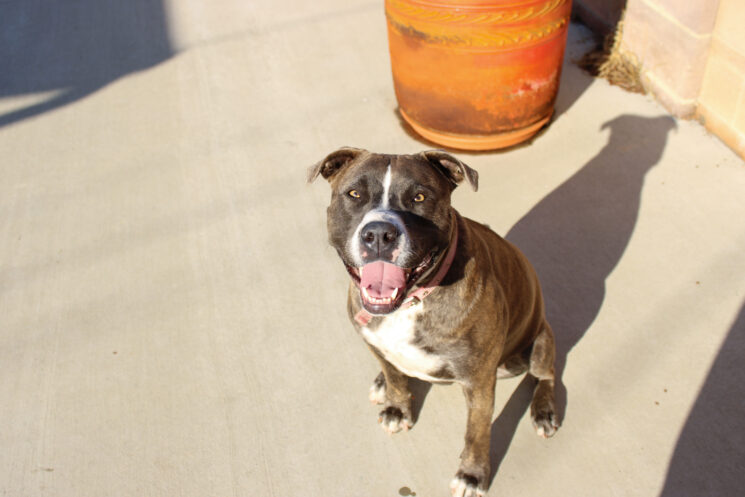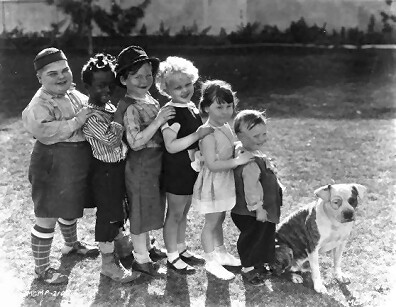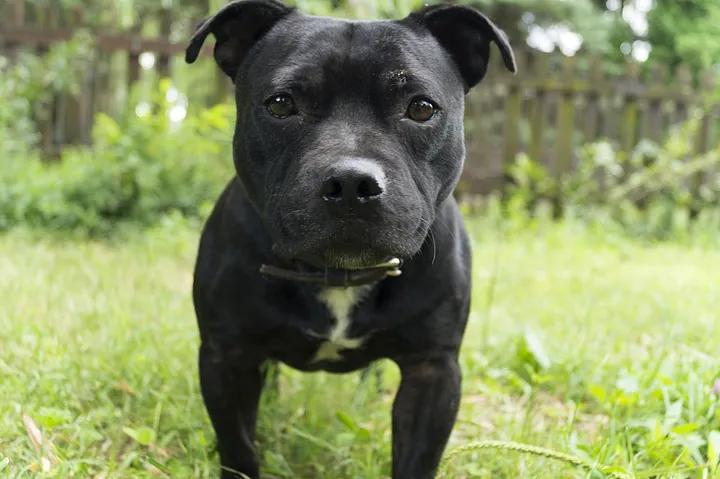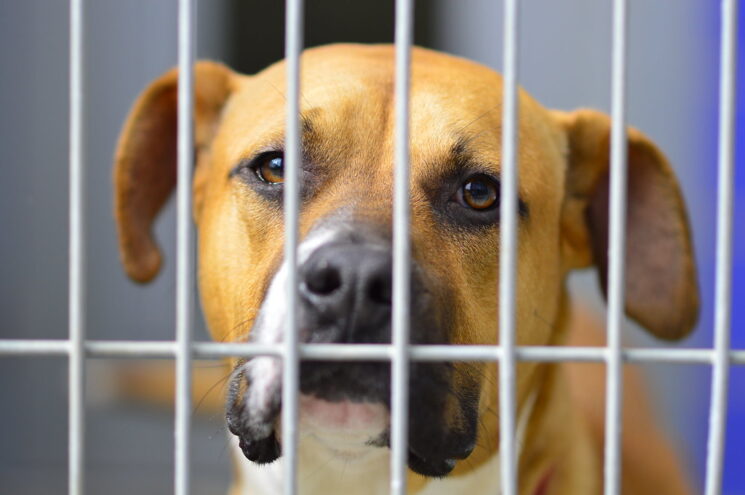
By Caroline Mora
The pit bull terrier is a strong, confident and loyal breed with the worst reputation of all. A quick Google search finds that the pit bull is considered “the most dangerous dog breed” and that they are more likely to “turn” on their owners than other breeds.
Due to their misunderstood history, pit bulls are often seen as dangerous and violent, leading them to be one of the most common breeds found in animal shelters. I would like to talk about the myths that perpetuate this stereotype and debunk a few along the way. I spoke to Stephanie Palmer, a teacher at Fountain Valley High School, a seasoned volunteer at Priceless Pets as well as a foster dog mom who provided insight as to why irresponsible dog ownership only makes matters worse.

A brief history
Pit bulls were bred in the 1800s from old English bulldogs for the sport of bull baiting — the act of pitting dogs against bulls and other large animals such as bears and horses. It wasn’t a new sport, but it was a favorite in Great Britain. This was done for entertainment purposes, and people would bet on the results of matches. In 1835, bull baiting was made illegal as it was seen as animal cruelty.
Unable to give up their favorite pastime, people turned to ratting, where pit bulls were put in a pit and meant to fight rats. This is actually where the term ‘pit’ bull originates. After a while, dog fighting gained popularity, pitting dogs against dogs. Owners bred pit bulls to be fast and agile, as well as tolerant towards humans. They wanted to ensure that if needed, a person could interfere in the fight and would not get bit.
When the British colonized the land in early America, they brought their pit bulls along with them. Instead of being used for dog fighting, the majority were used as working dogs. They helped to herd cattle and guard livestock as well as families. They were especially protective of children, earning them the title of “nanny dog.”
During World Wars One and Two, pit bulls were used in combat and seen as America’s mascot. Pit bulls were revered as loyal, affectionate and protective dogs and people from Theodore Roosevelt to Hellen Keller owned them.
In 1976, America began to crack down on dog fighting. Despite it being a felony in all 50 states, dog fighting regained popularity in the 1980s. Their breed of choice? The pit bull. This in turn made pit bulls associated with violence, poverty and criminal activity.
“I think pit bulls have gotten a bad rap over the years, and they’ve been pigeon-holed into this stereotype. Because they’ve been used by horrible people for dog fighting and guarding for illegal drug operations, this has perpetuated the stereotype,” Palmer said.
In 2007, former NFL quarterback Michael Vick’s home was raided and it was discovered over 70 dogs, most of which were pit bulls, were on the property, abused and malnourished. There was also evidence to suggest that Vick had financially supported and owned a dog fighting ring. Instead of euthanizing all of these dogs, 51 dogs were given to shelters that asked for them. 48 out of the 51 dogs were able to be fostered and adopted, challenging the belief that these dogs were bred to be aggressive and could never be a loving companion.
Today, there is still a stigma associated with pit bulls, but efforts to educate and advocate for them have increased. Pit bulls can be seen performing jobs in law enforcement, search and rescue, as service dogs and therapy dogs in children’s hospitals, women’s shelters and hospices.

Pit bulls myths
One of the most common myths about pit bulls is that they have a locking jaw, and along with it, the strongest bite. There is no evidence to suggest that these dogs, or any other breed, can lock their jaws at will. If their jaw does indeed ‘lock,’ it is not by choice, and they might want to get it checked out by a veterinarian if it starts occurring regularly.
As for the strength of their bite, it’s about 240 up to 330 pounder per square inch (PSI). Whereas other breeds like the cane corso, the American bandogge and the kangal all have bite forces ranging from 700 to 734 PSI.
Pit bulls have also been the victim of unfair statistics. In the media, most dog attacks reported on in the news are done by pit bulls. The media plays on society’s negative perception of pit bulls by choosing these stories to highlight and disregard other stories about different breeds. A lot of times, the dog might not even have been a pit bull but another breed with similar features.
Since the general public already expects this behavior from pit bulls, they just add more fuel to the fire and are less likely to change their negative perception of pit bulls.
Another popular myth about pit bulls is that they are likelier to ‘turn’ on their owners or attack without reason. No act of aggression by any animal is done without reason. This might not mean that you did anything inherently wrong, but the dog might have felt uncomfortable or threatened by you even if it wasn’t your intention.
The dog did probably give signals to indicate how they felt, but they went unnoticed. It can be hard for people to correctly decipher these signals as they are oftentimes subtle, small changes in posture or ear position. Mistaking uncomfortable behavior for submission is one of the most common reasons for dog bites.

Shelter dogs
Of all the dogs in animal shelters, pit bull-type dogs make up about 33% of the population, making them one of the most common dogs to find in a shelter. Many pit bulls are surrendered or taken off the streets into shelters and are euthanized upon arrival, or euthanized later. Either way, this gives pit bull types a 93% euthanasia rate in the United States.
“[And yes,] pit bulls are more likely to be euthanized — both because of their bad reputations and the fact that they are harder to get adopted because of all the negative press,” Palmer said.
More pit bulls will enter the shelter than leave, not only because of their reputation but because of shelter policies. For example, the Orange County Animal Shelter shut down walk-throughs and began asking visitors to make an appointment for two specific dogs at a time. This policy began in 2020, in response to COVID-19 procedures even though the pandemic ended officially last March, the shelter continues to enforce this policy.
Forcing people to make an appointment to see animals makes it ‘too hard’ for the average person if they just want to see the animals. Before they put these policies into action, you could simply walk in and look at all the dogs. If you met one you had a connection with, you could potentially walk out with a new furry friend that same day.
Now, you choose which animals you would like to meet based on their profile online. Their profile displays their picture, sex, breed, age, intake date and intake jurisdiction. There are a few dogs with comments about their temperaments, so you only have their breed and age to go off of.
Pit bulls are less likely to be rescued than other breeds. The top three most common breeds to find in a shelter are pit bulls, German shepherds and huskies.
“Shelters are filled with pit bulls, huskies and German shepherds. This could be caused by a number of factors, but most likely they end up there because cute little puppies turn into large adult dogs who need a LOT of consistent training,” Palmer said.
Irresponsible ownership and lack of research before shopping for pets lead to an overwhelming amount of these breeds in shelters. Then due to stigmas, they don’t get adopted and are left to live in a cage until they are euthanized.

Are pit bulls dangerous?
The short answer is yes, but they’re not dangerous because they are pit bulls. Any dog is dangerous and has the potential to harm. You should take precautions whenever handling an animal that you’re unfamiliar with.
“And sure, any dog can be dangerous, depending on many circumstances,” said Palmer.
Although it’s important to remember that it’s not the breed that makes the dog dangerous, it’s the fact that it’s a dog. I’ve personally encountered far more aggressive chihuahuas and Australian shepherds than pit bulls.
Pit bulls are known for being affectionate, cuddly and personable. They have a rough play style, which can often be mistaken for outright aggression. They growl and bark when playing and they love to play tug of war. They are an intelligent breed who are eager to please, meaning they are very trainable. They have the capacity for aggression if you foster that sort of behavior. Abused dogs are more likely to display aggressive behavior than dogs that live in a humane home.
“A lack of training or intentional training for aggressive behavior must be blamed on an irresponsible owner,” Palmer said.
As a pet owner, you need to be responsible at all times. Choosing the right dog for your lifestyle is an important decision and one that shouldn’t be taken lightly. Too many animals end up in shelters because their former owners didn’t do their research. If you have the time and patience to get a new puppy, ensure you do so knowing it’s a huge responsibility and commitment. If puppy training isn’t your style, “adopt don’t shop” is always a great motto to live by. There are plenty of well-behaved dogs in shelters waiting for you to take them home. And the next time you’re in the market for a furry friend, consider a pit bull.





